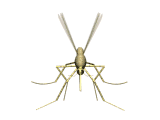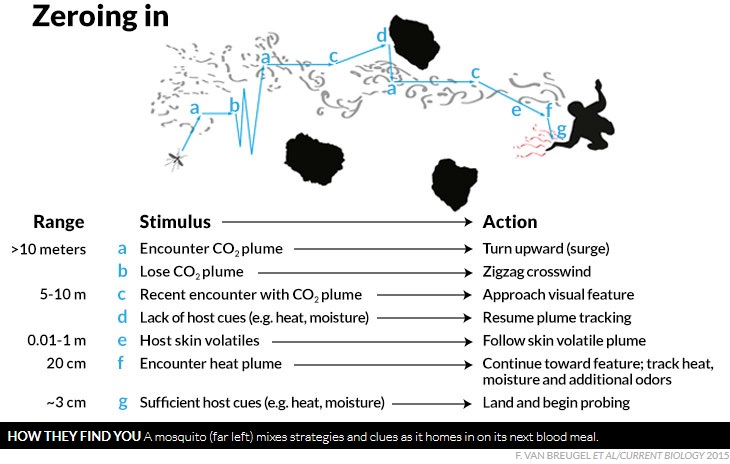 How Mosquitoes Find You - September 2, 2015 Jeff Schalau, Agent, Agriculture & Natural Resources University of Arizona Cooperative Extension, Yavapai County Predators search the environment for cues that lead them closer to their prey. Using their various senses, they navigate using both their trajectory through space and the distribution of stimuli or cues they detect in the environment. Studying these cues helps us understand predator behavior and ultimately allows us to reduce losses to predation. Earlier this year, researchers published a study describing how mosquitoes locate a suitable blood meal. This discovery could decrease the incidence of mosquito-vectored diseases and positively impact human and animal health. The study indicated that mosquitoes find suitable prey using multiple senses. They detect carbon dioxide (CO2) exhaled by prey species, they can see high-contrast objects, and, once they get close, they can sense the warmth, moisture, and volatile compounds being emitted by prey. As they travel through the environment, mosquitoes integrate these factors to successfully locate prey. CO2 plumes emanate from living prey, but are made discontinuous in the breezy outdoors, breaking them into scattered floating puffs. A lag in the insect’s nervous system can cause it to fly through the puff before it can finish turning toward the source. When tests were performed in wind tunnels, researchers noted that mosquitoes flew out of perfectly good plumes of CO2 to investigate other sensory clues. Tracking equipment allowed the researchers record the “flight waverings” and swoops of individual insects in the tunnel. These experiments were designed to look at how mosquito preferences interact. The researchers found that CO2 triggers female mosquitoes (Aedes aegypti) to start exploring visual contrast. When there was no extra CO2 in the tunnel air, females flew here and there but didn’t pay special attention to contrasting objects on the floor. Adding an extra whiff of CO2 to tunnel air inspired the mosquitoes’ interest in features that stood out — plastic filters, glass squares or even spots of projected light that contrasted with the light or dark tunnel floors. They also found that heat, human volatile compounds (like “sweaty socks” odor), and moisture increased mosquito attraction when combined with visual contrast and CO2 plumes. These results are increasing our understanding of mosquito behavior and could help us reduce incidences of mosquito-borne diseases. Once you’ve attracted some mosquitoes, you may be wondering how best to repel them. Deet (N, N-Diethyl-meta-toluamide) is still the most effective active ingredient in personal mosquito repellents. If you are sensitive or otherwise concerned, consider applying it to a specific hat or shirt rather than directly to your skin. Other active ingredients in mosquito repellents include geraniol, citronella oil, eucalyptus oil, garlic, basil, neem, catnip, birch, bluestem grass, rosemary, spearmint, peppermint, cinnamon, and others. Few of these work as effectively as deet. Reduce mosquito breeding areas by eliminating standing water. Use using floating "donuts" or "dunks" in drinkers and water features mosquitoes breed. These contain Bacillus thuringiensis v. israeliensis (Bti) which control mosquito larvae in standing water. Replace or repair screens on doors and windows or use mosquito netting in sleeping areas. When outdoors, wear long sleeved shirts and long pants and apply mosquito repellents when mosquitoes are abundant. Reduce standing water in your garden by removing empty beverage containers, discarded tires, or any other item that will create a mosquito breeding area. Buckets, barrels, birdbaths, and other water vessels should be either emptied twice per week or have one of the above-mentioned floating "dunks" placed in it. As described above, mosquitoes are attracted to CO2 and traps have been developed to capitalize on this attraction. Another attractant used is octanol: a fatty alcohol. These traps are effective in closed environments, but are less effective at reducing mosquito biting rates outdoors. Other trap designs use ultraviolet and other light sources light to attract flying insects. These are not effective on mosquitoes and attract and kill many harmless and beneficial insects. Lastly, we come to the battery-powered, personal mosquito repellers. Some of these purport to use sound to repel mosquitoes. These devices are ineffective. The other type has a fan, a replaceable repellent strip, and some also have a heating element to help volatilize the repellent. These devices seem to work where mosquito pressure is low to moderate, but not so well when you are in serious mosquito country. For more mosquito behavior and repellent information, see below. Follow the Backyard Gardener on Twitter – use the link on the BYG website. If you have other gardening questions, call the Master Gardener help line in the Camp Verde office at 928-554-8992 or e-mail us at verdevalleymg@gmail.com and be sure to include your name, address and phone number. Find past Backyard Gardener columns or provide feedback at the Backyard Gardener web site: http://cals.arizona.edu/yavapai/anr/hort/byg/. Additional Resources Good Luck Outsmarting a Mosquito Science News, Vol. 188, No. 4, August 22, 2015, p. 15, by Susan Milius cals.arizona.edu/yavapai/anr/hort/byg/archive/howmosquitoesfindyou.html  This graphic accompanies the article listed above: Good Luck Outsmarting a Mosquito. Mosquitoes University of Arizona Cooperative Extension extension.arizona.edu/sites/extension.arizona.edu/files/pubs/az1221-2013.pdf Choosing a Bug Repellent University of Arizona Cooperative Extension extension.arizona.edu/sites/extension.arizona.edu/files/pubs/az1311.pdf Mosquito Management Colorado State University Extension www.ext.colostate.edu/westnile/mosquito_mgt.html |